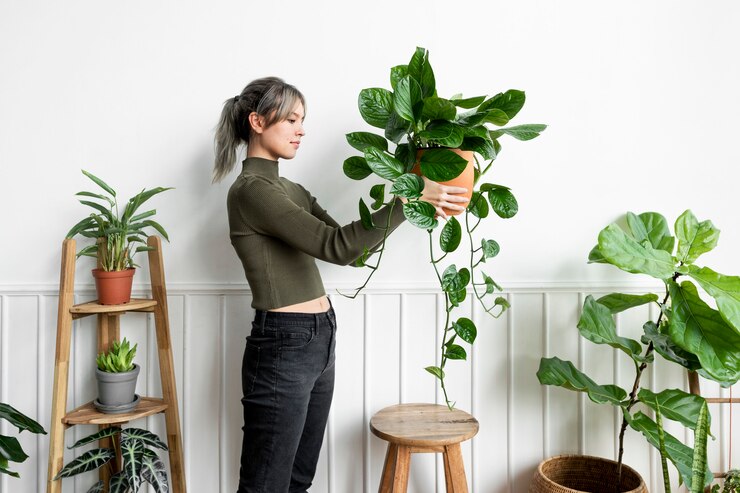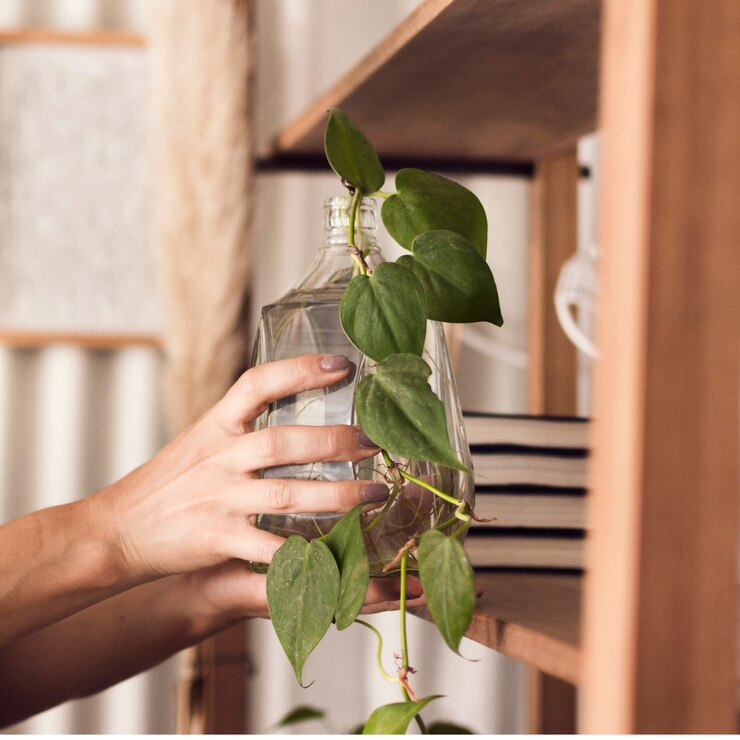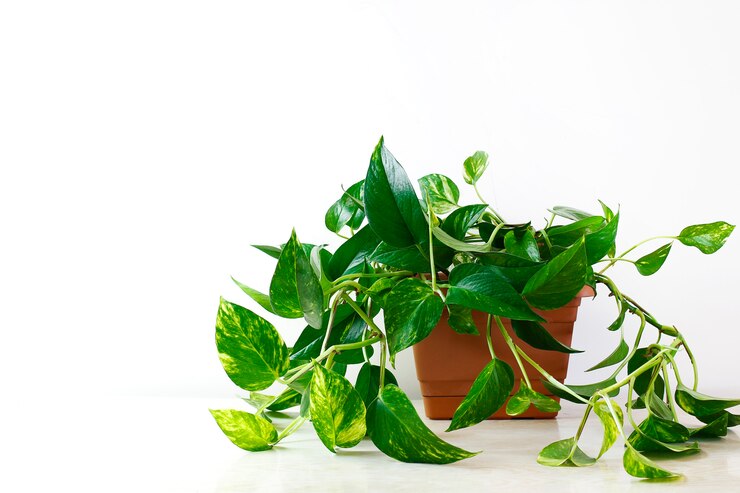
If you’re stuck with low sunlight. Then let us introduce you to Devil’s Ivy. A strong, vibrant indoor houseplant perfect for low-light spaces.
Devils Ivy isn’t just your average houseplant. It is perfect because it not only survives in low light but practically blooms. Making it ideal for homes with limited natural light.
Beyond its beauty. Devil’s Ivy is a fast-growing, air-purifying houseplant that adds beauty to any space. It’s easy to grow, maintain and multiply indoors.
In this guide, we’ll show you the easy steps to help your Devils Ivy plant grow and spread. Making your home filled with vibrant, green energy.
Let’s get started!
Devil’s Ivy Plant Profile
| Feature | Devil’s Ivy |
| Varieties | Devil’s Ivy is also known as Golden Pothos or Epipremnum aureum. “Aureum”, “Snow Queen”, and “Marble Queen”. |
| Height | Can grow up to 4 to 6 meters and spread wide. If kept indoors, it might not get that big. |
| Foliage | Keeps green, shiny, heart-shaped leaves. Some have patterns on the leaves depending on the type. |
| Climate | Originally from warm and cool places. But does well inside in most weather. |
| Soil | Likes a light, airy, and well-draining soil. |
| Growth | Grows well in the shade outside. Likes bright light but can handle low light too. |
| Flowering | Rarely blooms inside. If outside, it grows purple/green flowers. |
Why Devil’s Ivy Is Best Indoor Houseplant

1st Reason: Easy Placement
Whether you’re a plant pro or just starting. Devils Ivy indoor plant is an excellent choice.
You can put it in a regular pot, hang it, or let it climb on a moss pole. And even place it in a craft pot basket for a touch of creativity.
2nd Reason: Multiple Varieties
Devil’s Ivy indoor plants have different types and leaf patterns. They offer unique foliage. It’s a collector’s dream. New varieties are constantly being cultivated. Keeping the plant out of the ordinary.
3rd Reason: Easy Propagation
Devils Ivy is easy to propagate in a simple hydroponic setup.
- Just cut stemming plants below a leaf node.
- Place it in a glass vase.
- Let tiny roots grow.
- And then shift it to a pot for a blooming new plant.
4th Reason: Low Maintenance
Devil’s Ivy is a tough houseplant. It survives with minimal care. It’s budget-friendly and grows fast. You can find larger plants for instant home impact in any room.
5th Reason: Urban-Friendly
Indoor ivy plants are ideal for urban people who lack natural light. Devil’s Ivy requires a bit of TLC. But it’s totally doable in a low-light apartment with limited space.
How to Plant and Grow Devil’s Ivy
Plant Devil’s Ivy
When you plant Devils Ivy Bunnings. Add some slow-release food for the plant. This helps it grow well.
In the warm seasons, give the plant liquid food that dissolves in water. But, remember! Don’t feed it during the cold and wet winter months.
Soil Matters
Good soil is crucial for plant growth. Devil’s ivy can thrive in various soils, from acidic to alkaline.
Make sure the soil doesn’t stay too wet. This can lead to root rot. Let the soil surface dry completely before watering again.
Don’t worry too much about not watering enough. Devil’s Ivy can handle minimal watering and can survive dry periods and neglect.
Indoor Planting Essentials
If you’re planting devil’s ivy indoors, use a high-quality potting mix. Add some sphagnum moss or cocopeat to keep the plant healthy and strong.
Prune Regularly
Why prune? Trimming climbing indoor Devils Ivy is important to control its size and shape. Without a trim, it might spread too much. Especially in warm areas.
When to prune? Timing matters. Prune in spring and early summer. Remove no more than a third of the total foliage. Water a day or so before pruning for best results.
Avoid overgrowth. If you let Devil’s Ivy grow unchecked. It can become invasive. Regularly cutting the stems helps keep them in check.
Always use sharp and clean tools, like secateurs. Trim about half a centimetre after a growth point.
Prune yellowed leaves. If some leaves turn yellow due to too much water. Gently bend and snap them off for a healthier plant.
Soil Problems, Diseases and Pests
Devil’s Ivy is usually strong against disease and bugs. But some troubles come from the soil.
Sometimes, there are issues with the soil. Diseaseslike root rot and spots on leaves happen when you water too much during the growing time.
If it gets too cold (below 10°C), or if your plant is thirsty, the leaves might get all limp and curly.
Tiny bugs called spider mites and mealy bugs can be a headache. Luckily, you can fix this by spraying your plant with bug spray. Do it again after 2 weeks to make sure the bugs are totally gone.
Signs of Plant Stress
Multiple brown and falling leaves signal plant stress. This stress can stem from issues with light, water, temperature, drafts, humidity, pests, or diseases.
Signs of Overwatering
- Wilting Plant: If the plant looks droopy.
- Brown Leaf Tips: If the tips of the leaves are turning brown.
- Yellow and Mushy Leaves: If the leaves are yellow and feel mushy.
- Wet and Smelly Potting Mix: If the soil is consistently wet and has a bad smell, let it dry out more between waterings.
Signs of Underwatering
- Wilting Plant: If the plant appears limp.
- Dry and Shrivelled Leaves: If the leaves look dry and shrivelled.
- Shrinking Potting Mix: If the soil pulls away from the pot’s edges, indicating insufficient watering.
How To Propagate Devil’s Ivy
- Cut the Stem
- Snip a piece of the stem or stem tips just below a node (where leaves grow).
- Root in Water
- Put the cut end of the stem in water for up to 2 weeks.
- Wait until you see shoots starting to grow.
- Plant in Soil
- Once shoots appear, plant the vine in the soil to let it grow.
- For Long Trail Stems
- If you have long stems with airborne roots:
- Cut them off.
- Place them in a mix of peat and coarse propagating sand or a seed and cutting mix.
- Alternatively, peg them down into pots with wire or hair clips.
- Grow It Independently
- Once they’ve developed enough roots.
- You can cut them off from the parent plant and treat them as individual plants.
Devils Ivy Care Guide | 6 Simple Tips
- Re-pot Every Couple of Years: Keep your plant happy and healthy by changing its pot every few years.
- Feed from Spring to Autumn: From spring to autumn, feed your Devil’s Ivy every 2 months.
- Keep it Tidy: Maintain a tidy appearance by removing brown leaves. Also, gently wipe the leaves to get rid of dust.
- Trim for Bushier Growth: If stems get too long or you want a bushier plant. Trim the stems. You can create more plants by placing these stem pieces in water. Make sure each piece has at least two nodes for roots and shoots to develop.
- Protect from Fungus Gnats: If tiny winged insects (fungus gnats) bother your indoor plants. Sprinkle anti-Gnat pellets on the potting mix surface. This keeps female fungus gnats from laying eggs. Messing up their life cycle.
- Bright Light for Variegated Ivy: Variegated Devil’s Ivy with colourful patterns needs brighter light to maintain its leaf colours.
How to Grow Devil’s Ivy in a Pot: Step-By-Step Process

- Choose a Good Pot
Pick a pot with holes at the bottom for water drainage. Use quality potting mix like Yates Specialty Potting Mix for Indoor Plants & Ferns.
- Prepare the Plant
Take the plant out of its container. Gently untangle the roots and trim any twisted ones. Give the leaves a light trim to promote new growth.
- Plant in the Pot
Place the plant in the middle of the pot and fill it with potting mix. Press down gently. Water the plant well.
- Guard Against Bugs
Stop fungus gnats by adding a layer of Yates Gnat Barrier on top of the soil.
- Water Correctly
Water the plant when the soil is dry. Stick your finger in – if it’s dry, water it. If it’s moist, wait a few days.
- Feed Regularly
From spring to autumn, feed the plant every two weeks. This feeding schedule keeps it nourished for 2 months.
How to Water a Potted Devil’s Ivy Plant
- Keep Soil Moderately Moist: Devil’s Ivy likes its soil somewhat damp. Ensure the pot has holes at the bottom for water to drain.
- Avoid Waterlogged Pot: If there’s a saucer or decorative cover pot, don’t let the Devil’s Ivy sit in the water. Empty excess water soon after watering.
- Weekly Soak Outside: Water the plant inside weekly. But sometimes take it outside for a thorough soak. This helps flush out salts from fertilizers and lets you wash the leaves.
Devil’s Ivy Benefits
- Indoor Air Purifier: Devil’s Ivy helps reduce asthma and allergy triggers by clearing air contaminants and Mold, improving indoor air quality.
- Bring Luck & Fortune: Devil’s Ivy is considered a lucky plant in Asian countries. Many believe Devil’s Ivy brings good fortune and prosperity to homes and offices.
- NASA-Approved Purifier: Featured in NASA’s Clean Air Study, Devil’s Ivy eliminates indoor pollutants. Like formaldehyde, trichloroethene, toluene, xylene, and benzene commonly found in household cleaning products.
- Hydroponic Plant: Devil’s Ivy grows well in hydroponic settings. Offering a fancier option for growth beyond traditional soil methods.
- Aquarium Cleaner: Placing Devil’s Ivy on aquariums benefits both the plant and the aquarium. Its roots absorb nitrates from the aquarium and contribute to water cleanliness.
Enjoy the Charm of Devil’s Ivy
In a nutshell, growing and propagating Devil’s Ivy indoor plants is easy. Remember that this strong plant offers beauty and benefits effortlessly.
From its air-purifying qualities to easy growing and propagation. Devil’s Ivy is a perfect plant for indoor plant growers.
Keep it simple. Provide the right care, and watch your Devil’s Ivy adds beauty and freshness to your home. Find a ‘hydroponic garden near me’ and bring an evergreen plant to your home today.
Start Hydroponic Gardening Perth with Creative Grow Store
Explore the essentials of hydroponics with the finest selection at Creative Grow Store.
Whether you’re searching for a “hydroponics store near me” or seeking expert advice on hydroponic gardening in Perth. We have got you covered.
Our hydroponic shops Perth are dedicated to providing top-quality supplies for your hydroponic garden. Explore our extensive range of hydroponic supplies and equipment that fits every level of expertise.
